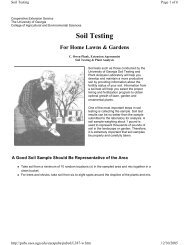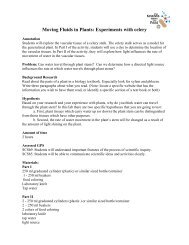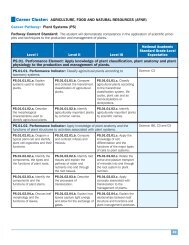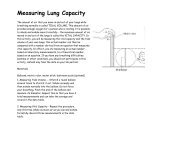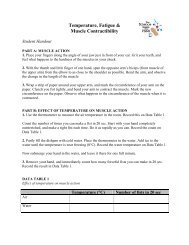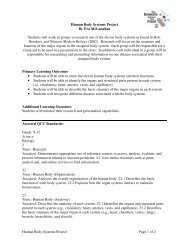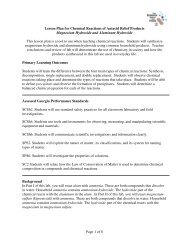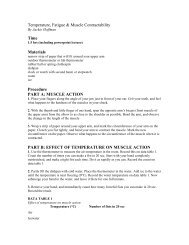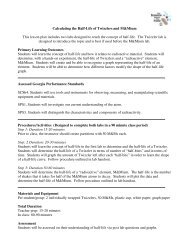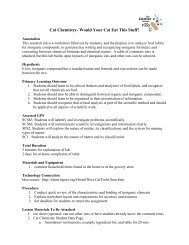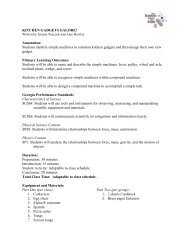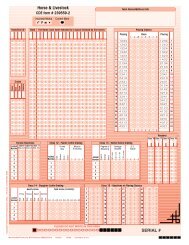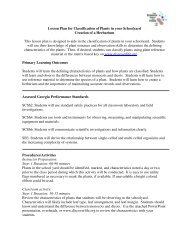Basic Agriculture Science - Georgia Department of Education
Basic Agriculture Science - Georgia Department of Education
Basic Agriculture Science - Georgia Department of Education
You also want an ePaper? Increase the reach of your titles
YUMPU automatically turns print PDFs into web optimized ePapers that Google loves.
<strong>Georgia</strong> <strong>Department</strong> <strong>of</strong> <strong>Education</strong><br />
Course Standard 8<br />
AFNR-BAS-8<br />
Identify the different areas <strong>of</strong> agriscience and relate the scientific classification system to<br />
organize and research the agriscience field.<br />
8.1 Define biotechnology and create a timeline <strong>of</strong> biotechnology milestones.<br />
8.2 Explain the importance <strong>of</strong> the scientific method in agriculture and list examples <strong>of</strong> current<br />
agriculture research.<br />
8.3 Design, implement, collect data, and determine conclusions by conducting scientific<br />
experiments in any field <strong>of</strong> agriculture.<br />
8.4 Research and report current agricultural biotechnology events or products.<br />
8.5 Analyze skills, education requirements, income, and advantages and disadvantages <strong>of</strong><br />
careers in agriscience/biotechnology fields.<br />
Support <strong>of</strong> CTAE Foundation Course Standards and Common Core GPS and <strong>Georgia</strong><br />
Performance Standards<br />
ELACC9-10SL1: Initiate and participate effectively in a range <strong>of</strong> collaborative discussions (oneon-one,<br />
in groups, and teacher-led) with diverse partners on grades 9–10 topics, texts, and<br />
issues, building on others’ ideas and expressing their own clearly and persuasively.<br />
ELACC9-10SL2: Integrate multiple sources <strong>of</strong> information presented in diverse media or formats<br />
(e.g., visually, quantitatively, orally) evaluating the credibility and accuracy <strong>of</strong> each source.<br />
ELACC9-10SL4: Present information, findings, and supporting evidence clearly, concisely, and<br />
logically such that listeners can follow the line <strong>of</strong> reasoning and the organization, development,<br />
substance, and style are appropriate to purpose, audience, and task.<br />
SCSh3: Students will identify and investigate problems scientifically.<br />
a. Suggest reasonable hypotheses for identified problems.<br />
b. Develop procedures for solving scientific problems.<br />
c. Collect, organize and record appropriate data.<br />
d. Graphically compare and analyze data points and/or summary statistics.<br />
e. Develop reasonable conclusions based on data collected.<br />
f. Evaluate whether conclusions are reasonable by reviewing the process and checking<br />
against other available information.<br />
Course Standard 9<br />
AFNR-BAS-9<br />
Define major components <strong>of</strong> the animal industry and outline the development <strong>of</strong> the<br />
resulting products, services, and careers.<br />
9.1 Analyze the role, importance, and scope <strong>of</strong> the dairy, beef, pork, poultry, equine, and small<br />
ruminant animal industries in modern agriculture.<br />
9.2 Identify and describe major breeds within each livestock segment.<br />
9.3 Explore the importance <strong>of</strong> alternative livestock in animal agriculture.<br />
9.4 Define key terminology related to animal science and production practices (fact vs. fiction).<br />
9.5 Distinguish between animal welfare and animal rights.<br />
9.6 Explain the basic anatomy and label basic external parts <strong>of</strong> production animals.<br />
<strong>Georgia</strong> <strong>Department</strong> <strong>of</strong> <strong>Education</strong><br />
Dr. John D. Barge, State School Superintendent<br />
January 25, 2013 ·Page 5 <strong>of</strong> 9<br />
All Rights Reserved



